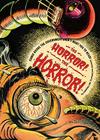 David Hadju's The Ten-Cent Plague is a narrative history of the comic-book genre, from its origins in the newspaper comic strip to its newsstand-grabbing sensationalism to the Congressional hearing that led to its (temporary) decimation. He interviewed dozens of writers and artists who worked on the sometimes-controversial comic books, and quotes them ad infinitum (to his credit, he does note when their testimony seems more self-serving than truthful). It's an interesting story, a tale of populist culture vilified and ultimately censored by the quasi-scientific and law enforcement establishments. But I do feel that Hadju falls too easily and too often into the Those Repressed Fifties Folk trope, wherein it goes without saying that any objections on the part of parents or government at the time was witch-hunting or quashing dissident (and, it's implied, correct) viewpoints. It's true that paranoia and fear cause overreactions, and blaming comics for juvenile delinquency was objectively untrue. I think, though, that were (and are) points to be made about the appropriateness of the images churned out by EC and its multitude of imitators: they were shocking, gory, grotesque. They were meant to be, and they were not on the whole meant to subvert the dominant paradigm and to expand the minds of children, to save them from the unbearable conformity of the times. They were designed to make money; anything else was a side effect.
David Hadju's The Ten-Cent Plague is a narrative history of the comic-book genre, from its origins in the newspaper comic strip to its newsstand-grabbing sensationalism to the Congressional hearing that led to its (temporary) decimation. He interviewed dozens of writers and artists who worked on the sometimes-controversial comic books, and quotes them ad infinitum (to his credit, he does note when their testimony seems more self-serving than truthful). It's an interesting story, a tale of populist culture vilified and ultimately censored by the quasi-scientific and law enforcement establishments. But I do feel that Hadju falls too easily and too often into the Those Repressed Fifties Folk trope, wherein it goes without saying that any objections on the part of parents or government at the time was witch-hunting or quashing dissident (and, it's implied, correct) viewpoints. It's true that paranoia and fear cause overreactions, and blaming comics for juvenile delinquency was objectively untrue. I think, though, that were (and are) points to be made about the appropriateness of the images churned out by EC and its multitude of imitators: they were shocking, gory, grotesque. They were meant to be, and they were not on the whole meant to subvert the dominant paradigm and to expand the minds of children, to save them from the unbearable conformity of the times. They were designed to make money; anything else was a side effect. One of the other problems with the book is its near-total lack of images, which is why I read it in tandem with The Horror! The Horror!, a collection that includes many of the crime and horror comics referenced by Hadju. And boy, there are some doozies! Melting faces, ax murders, lots and lots of pointy breasts--fun to look at for low-culture-appropriating adults like me, but honestly? I can see what worried parents. It also can't be denied that, with a few exceptions, these comics were badly drawn, poorly plotted, and cheaply printed. Well, strike that--both Hadju and Jim Trombetta, who contributes overly academic, sneering, insufferable essays* in between the comics collected here, would deny that. I think that damages their case, honestly. Rather than arguing for the preservation of these comics on artistic grounds, couldn't they simply point out that censorship is wrong even when what's being censored is no great loss?
One of the other problems with the book is its near-total lack of images, which is why I read it in tandem with The Horror! The Horror!, a collection that includes many of the crime and horror comics referenced by Hadju. And boy, there are some doozies! Melting faces, ax murders, lots and lots of pointy breasts--fun to look at for low-culture-appropriating adults like me, but honestly? I can see what worried parents. It also can't be denied that, with a few exceptions, these comics were badly drawn, poorly plotted, and cheaply printed. Well, strike that--both Hadju and Jim Trombetta, who contributes overly academic, sneering, insufferable essays* in between the comics collected here, would deny that. I think that damages their case, honestly. Rather than arguing for the preservation of these comics on artistic grounds, couldn't they simply point out that censorship is wrong even when what's being censored is no great loss?*If I had stopped reading these in-between bits after rolling my eyes at the first few, I would have enjoyed the book, like, 75% more. That's what I recommend for anyone not looking to relive their days in grad school lit.








Hey, just because they were badly drawn, poorly plotted, and cheaply printed doesn't mean they wouldn't have been a great loss. A lot people loved these comics, and they were both a proving ground and influence on a lot of great artists.
ReplyDeleteFair enough. I suppose I'm just irritated by these authors' lack of acknowledgment that the merits of these comics were not wholly artistic. Especially since I'm personally inclined, often, to value things more because of what they meant to a people/culture emotionally, rather than some objective ideal of Art.
ReplyDelete